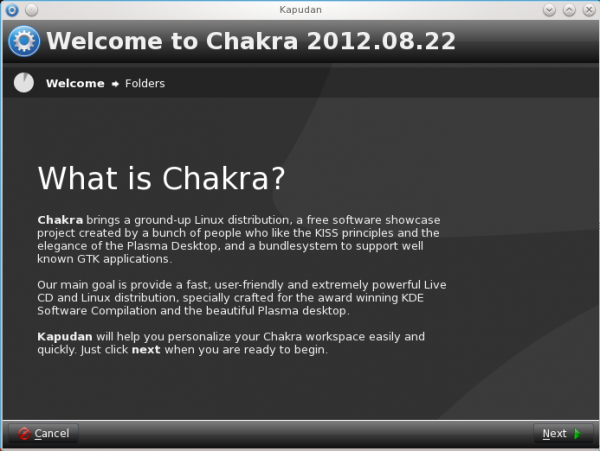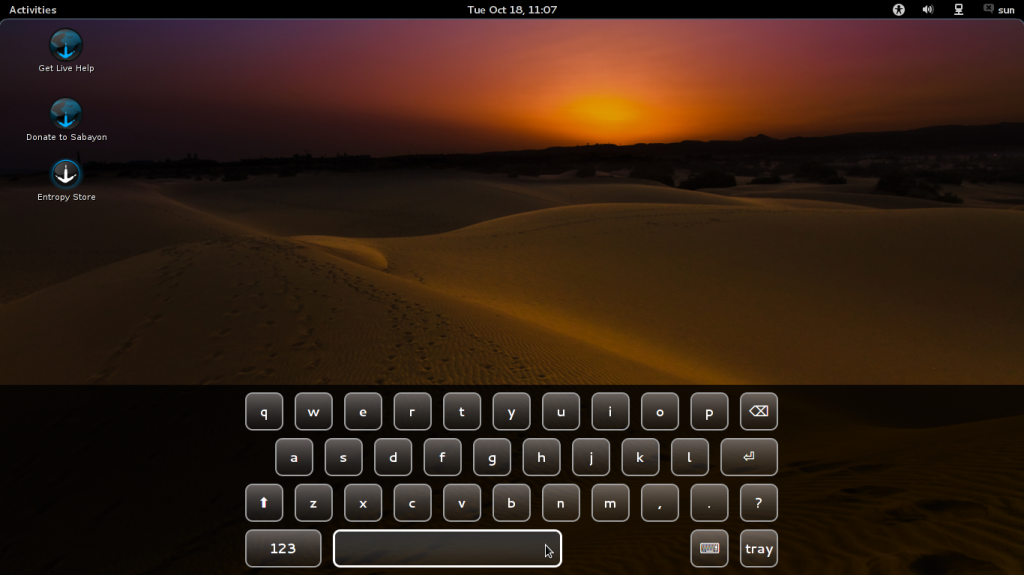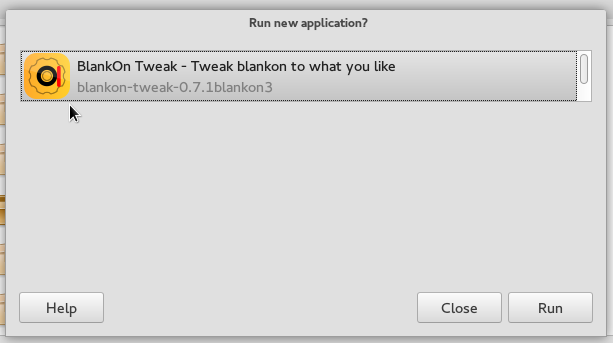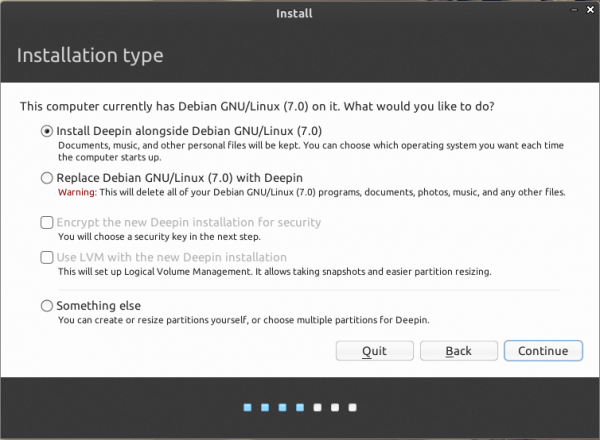Chakra 2012.08 review, code-named Claire, is the latest stable release of Chakra Linux, a semi-rolling release, desktop-centric, Linux distribution forked from Arch Linux.
Chakra uses the K Desktop Environment (KDE) exclusively, so it is no surprise then that Chakra 2012.08 was named after Claire Lotion, a popular figure in the KDE community who passed away recently.
As the name suggests, Chakra 2012.08 was released back in August, and like other distributions that use the rolling or semi- or half-rolling development model, an updated ISO installation image has since been released (that was in September).
Chakra Claire comes with its share of new and old/updated features. One new feature (if it qualifies as a feature) that will affect what type of machine you can install it on, is that support for i686 platforms was discontinued. Which means that only a 64-bit installation image was released. The reasons, as an official blog post put it, is that:
Since all who work on Chakra and support it with packaging and coding are on x86_64 systems, it had become harder and harder to keep the same quality standard for all testing phases for i686, since no one would have their system in daily use for i686.
Also Chakra has grown at a much faster pace then anyone had anticipated. At the start of the split from Arch, that time an ISO release would have around 7000-10.000 downloads for a series. The Edn series (ISO’s following KDE SC 4.7.x ) had a total of about 100.000, now the last series, Archimedes, is at about 260.000. All those new users came with demands for all kinds of packages and features, and Chakra kept filling those demands as much as possible, disregarding the fact that the user demands was fast outpacing the number of volunteers actively supporting this distro. Maintaining about 7000 packages (bundles included) in a half rolling distro, at a quality level Chakra has set for itself, with 2-3 packagers doing the work on about 5000-6000 packages is not sustainable.
Hopefully everything outlined above makes it clear that dropping full support for i686 is the logical and necessary next step for Chakra. It will bring it back to a solid, sustainable level. And from now on, growth will only come from an expanding, dedicated volunteer base.
I do not know of any other distribution that has taken this step, and I am not sure what the long-term impact on the adoption of Chakra will be. Time will tell.
Another new feature that shipped with Chakra 2012.08, is Kapudan, a port of Kaptan, the graphical desktop customization utility in Pardus. Kaptan and Kapudan, are run on first boot, and can be run at any other time. It helps users customize several aspects of their desktop. It is the type of application that I think every distribution should have. (See Every distribution should have its own Kapudan.) Note: Kaptan is Turkish for “Captain,” but Kapudan does not really mean anything. It is just a spin on the original name.
This is Kapudan’s welcome screen. Its interface is all point-and-click.

A feature that Kapudan allows you to customize if the style of menu to use. In Pardus’ Kaptan, there are three, but that number rose to four in Kapudan. The Takeoff Launcher is the extra one in Kapudan.

Also new in this release, is KDE 4.9, updated to 4.9.1 in the September release. The desktop with the Kickoff menu is shown in the image below. As stated earlier, it is just one of four menu styles you can chose from Kapudan. The others are the Takeoff Launcher, Lancelot, and the Simple or Classic menu.

This is the same desktop with the Takeoff Launcher and a different wallpaper. Unlike with the Kickoff and Lancelot menus, there is no visible search box on the Takeoff Launcher, but start typing and it appears automatically, or automagically.

Since this is KDE, we must also mention the Netbook interface, even though it is doubtful that anybody still uses it, or has even used it for serious stuff. The KDE Plasma Netbook interface is actually fun to use, but for some reason, it never really became popular. Shown here, is the desktop as seen from the KDE Plasma Netbook interface.

A step in Kapudan lets you see all the security tools that you may use to secure your installation of Chakra 12.08. Aside from the firewall, which is installed but not enabled, the others have to be installed and configured. So, while you can just click to enable the firewall, clicking on, say, the Tomoyo-tools button will open a Web page that provides instructions on how to configure it. It would have been better if clicking on that button enabled and configured it. Maybe it will be so in a future release. The screen shot below shows the step in Kapudan.









Chakra is one of those distros that’s being polished every day but breaking it every time. So one step forward one step backward. I think the chakra devs need a new focus again.
J.A. Watson at ZDNet is an enthusiastic user of the KDE Netbook Desktop:
http://www.zdnet.com/kde-netbook-desktop-my-guide-to-configuring-and-using-it-7000001905/
Finid, rather than the Pardus installer, don’t you think it would be better for Chakra to borrow a graphical installer that supports full-disk encryption, such as Fedora’s or (once it’s stable) the new one from Ubuntu?
First, please note that Kapudan is not an installer, but a post installation helper. It doesn’t do anything about installing, but rather configures already installed software.
About using another distros installer:
Unfortunately, it is not possible to use the installer of a different distribution, because installers are highly distribution specific. They have specific code, which e.g. depends on the the package manager used by the distribution and the toolkits they use. However, it is possible to integrate some parts of other distros’ installers into our own installer, Tribe. About full disk encryption: That’s on the todo list, but not the most important thing at the moment. First and foremost some GSOC code needs to be merged upstream, which enables lvm support.
Is there any part of this article where I suggested that Kapudan is an installer?
For the record, and I’m not bragging, but I introduced Chakra’s devs to Kaptan, so I know what it’s supposed to do.
Not entirely based on facts, Kaptan was mentioned as an example to use, before Chakra split from Arch, in the winter of 2009/2010 (as part of the whole discussion why to split, what goals would be set, what package manager to use, etc.
For the rest, thanks for the review, very accurate, Chakra cannot be recommended to new Linux users, until full featured Tribe and akabei/GUI for package management are in place.
@finid: You didn’t, and I didn’t say that you said it. My reply was meant for David who wrote “Pardus installer”. And as one of the Kapudan devs I also know what I’m writing :-).
Anyways, honest and accurate review of Chakra, thanks for the time you’ve put into it.
@inkane: Read my comment again — I never said that Kapudan was an installer.
I was addressing finid’s suggestion in the review that in addition to porting Kapudan from Pardus, you might want to consider porting their installer, YALI, as well, since it’s already much better than Tribe is in its current state. He also suggested that it shouldn’t be too hard for you to add support for full-disk encryption to YALI.
My question was whether it would be simpler for you to port a different graphical installer that already supports full-disk encryption, such as Fedora’s Anaconda, or the soon-to-released Ubuntu installer. (I know Chakra is an Arch fork, but Sabayon manages to use Anaconda despite their Gentoo base.)
For a lot of us — especially laptop users — Chakra’s current lack of full-disk encryption in the installer is a deal breaker.
Hi, and thanks for this review of Chakra! 🙂
There’s some info on our wiki (http://www.chakra-linux.org/wiki/index.php/Kapudan) about why the name “Kapudan” was chosen for this tool. As for the security page, it is not currently planned to add configuration for any of the extra programs mentioned there. The buttons allow users to find out more about these tools and configure them themselves. If you see any problems with the wiki pages describing how to use those tools, please just let me know and I’ll try to clarify.
The “Kapudan Pasha” was a naval title in the Ottoman Empire, means about: admiral, or naval minister.
I like Chakra but with every single version I have the same problem…works fine running live but after installation I get a black screen. This is both on my desktop VMWare and full installation on laptop. Fortunately I came across Manjaro so I’m getting some experience with Arch there (and liking it).
What’s the graphical package manager on Manjaro like?
Here’s a review of Manjaro with screenshots, including the package manager (last screenshot, under the “Repository” subhead):
http://mylinuxexplore.blogspot.com/2012/09/manjaro-linux-081-xfce-review-fast.html